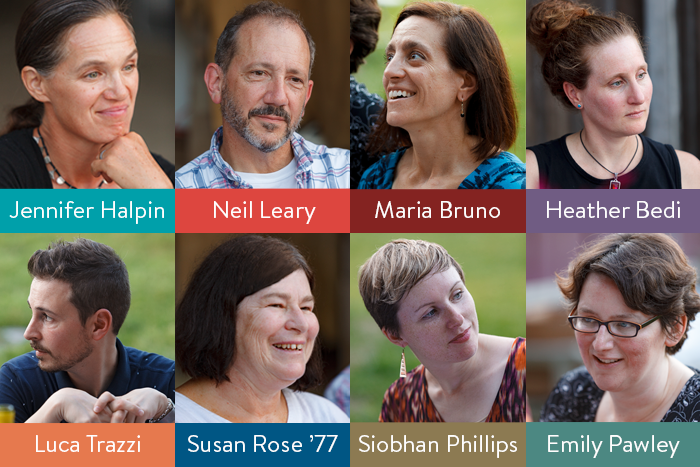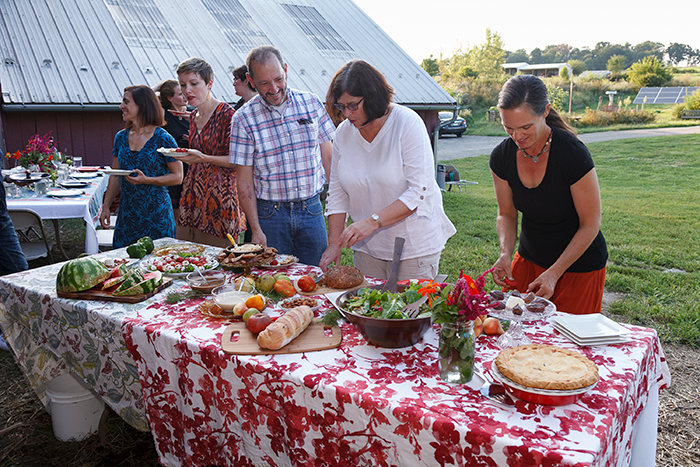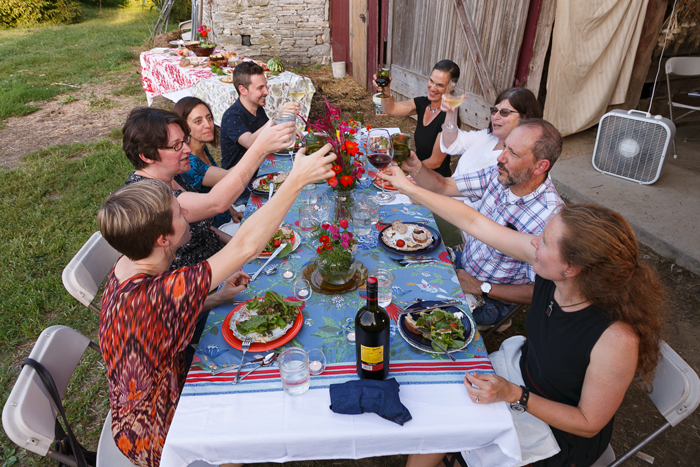Fertile Ground

Edited by Michelle Simmons; photography by Carl Socolow '77
Food is everywhere. Our culture is obsessed with it, from reality television to Instagram and Pinterest, and from the latest fad Paleo diet to dire warnings about obesity rates and eating disorders. But beneath all the hype and headlines are serious questions—about agricultural systems, political and socioeconomic inequality, globalization, art and culture, ecology, health and wellness—you name it. In other words, food is a liberal-arts issue, and when the faculty launched a food studies certificate program last spring, its curriculum reflected Dickinson’s multi- and interdisciplinary approach, along with its distinctive hands-on learning experience. In late August, we brought together some of the program’s founding faculty and, over a meal held at Dickinson’s College Farm—partly sourced by the farm and prepared by Dining Services—we discussed the origins of the program, and what food studies means for Dickinson and beyond. What follows are excerpts of the conversation, edited for length and clarity.
How did food studies at Dickinson get started? How did you become involved?
Neil Leary: There a couple of things that attracted me to the idea of a food studies certificate, one of which is the work that the Center for Sustainability Education is doing with infusing sustainability into the curriculum, which can be a fairly abstract set of ideas. Food is something that students are dealing with at least three times a day. It’s part of their daily practice, a daily ritual, and they’re interested in it.
Jenn Halpin: I’ve been at Dickinson for 13 years, and over those 13 years I’ve seen students come in with greater awareness, experience and passion on the subject of food. They’re much more aware in terms of their consumption, and it’s nice to meet them where they are and take them further.
Luca Trazzi: What was really exciting was how easy it was and how natural it was to develop the program. The courses that became part of the food studies certificate were already happening and had been happening for several semesters, possibly years. The excitement that was in every department was impressive. I loved the fact that we could interact with other divisions [in ways] that otherwise would not have been possible.
What exactly does food studies look like?
In addition to Introduction to Food Studies, an experiential component—such as an internship, independent study, field-based or laboratory research or a hands-on work experience—and a capstone seminar, students are expected to take four courses outside their major(s). Here are some examples:
- African American Foodways
- Chemical Energy'
- The Cultures of Food in Italy in the Middle Ages and Renaissance
- Families and Gender in Cross-Cultural Perspective
- Introduction to Soil Science
- Jews and Food
- Literature and Food
- Mother Earth: Religion and Sustainability
- Principles of Human Variation and Adaptation
What’s most exciting to you about the program?
Emily Pawley: It’s wonderful to teach with something that’s very familiar. I start with the iconic tomato. When you bring a tomato into class, the students are like, a tomato? And then you start to talk about who touched it—literally, who touched it all along its way here. Immediately, it’s not only concrete and not only a familiar object, but then they realize they don’t know anything about it. That kind of step outward is very easy when you have an artifact.
Susan Rose: One of the things that was really exciting to me is that it has happened organically, as the farm is also organic. A lot of work went into it from various quarters, but things were already there. There’s also the interest in equality and labor, that we can be thinking about not just culture and foodways, but also political economy, global commodity chains, social change and social movement. There are so many aspects—earth sciences, chemistry or biology, or the humanities and social sciences.
Siobhan Phillips: You can’t really do food studies without being multidisciplinary. In a sense, Dickinson is cutting edge just by being who we are. Our students are experiencing a discipline that’s relatively young, so we’re doing something that takes advantage of what we have here but is also forging new paths. This is the kind of place where scholarship is emerging at intersections, while also respecting the integrity and methods of various disciplines. That’s something we at a liberal- arts college can do really well. It’s something that can happen here because of the flexibility and collegiality that we have.
Susan Rose: One of those intersections is with global education and sustainability, and also health studies. Also exciting for me is getting together with folks. A lot of the meetings were over meals. That also happens with students—with the intro and the capstone course we have built in experiential components. It’s really about the mind and the heart and the soul, and the ways in which civic engagement is involved, like with Project SHARE or finding ways in which food stamps can be applied to the farmers’ market.
Siobhan Phillips: It crosses places you wouldn’t even think of at first. We have great resources here in food history, anthropology and in culture, but also [Professor of American Studies and Women’s, Gender & Sexuality Studies] Amy Farrell’s work on fat studies, [Associate Professor of Psychology] Suman Ambwani’s work on eating disorders and [Professor of English and Poet-in-Residence] Adrienne Su’s work in poetry. There are all sorts of connections, even beyond the areas that would naturally be part of food studies.
Neil Leary: Sustainability is not homogeneous, but probably the most common way of thinking about it is. It’s not environmentalism, it’s not just another aspect of an environmental movement. There are some very important aspects that are interested in social justice and equity issues, economic livelihoods and inclusion. Food provides a set of issues and problems in ways that students can see them in a very pragmatic, everyday way. Food is a set of issues where the environment is very central and important, but it’s just one. For me, that makes it fertile ground for sustainability studies.

What are some of the key discussions and topics, your research and teaching interests?
Heather Bedi: I look at environmental activism and social movements, predominantly in India, but also in Bangladesh and Pennsylvania. Right now I’m working on a paper with another scholar about how food becomes a proxy for critiquing broader neoliberal trends in India. It’s interesting to think about how those narratives of culture are becoming narratives of protest.
I’m teaching a First-Year Seminar (FYS) on food justice, and the class is completely integrated with the Clarke Forum series on food this semester. I also teach environmental justice, and we spend time on how environmental and social inequality center on ideas of place—where people live and how that determines their access to food. A lot of the students end up looking at food deserts: What sort of food options are there? Are there supermarkets where they live? Do you need a car to get there?
In another class on environment and society, we did a project last spring and we’ll do it again, with Farmers on the Square [Carlisle farmers’ market]. The market has a Double Market Bucks program so people on federal food benefits can get double their money at the market. Last summer, they had a deficit of funds, and my students wrote a grant proposal to a local foundation, which awarded the program $2,000. We’ll do that again next year and integrate it further.
In my FYS, one of the students said, “I want to look at inequality and food access in developing countries.” I said, “We’re in a food desert right here in Carlisle.” It’s interesting for students to look at these trends globally, but I also want them to think about what’s happening here.
Jenn Halpin: I’ll add that courses like Spanish for Farm Workers [taught by Lecturer in Spanish Asuncion Arnedo-Aldrich] really help open the eyes of students who aren’t aware of domestic issues, even local issues, and I think Mosaics play a huge role.
Susan Rose: They help students understand the global-local connections, the ways in which they’re really connected. We’ve done Mosaics in Cuba and Venezuela, in particular, in sustainable agriculture, and there are the Mexican Migration Mosaics as well.
It’s been 10 years since the publication of Michael Pollan’s An Omnivore’s Dilemma, often considered the book that launched the most recent food revolution—at least from a popular perspective. What do you think? Did he help or hinder the movement? Are there others you think are more relevant/important?
Emily Pawley: There are a lot of people who have read a lot of Michael Pollan, and there are people who are reading a lot of critiques of Michael Pollan. One of the things that struck me in a conversation that came out of a Clarke Forum seminar is that the food movement has a lot of other people in it who don’t look like Michael Pollan. They don’t live in Berkeley, California. There are movements for environmental and food justice in places that don’t come out of this slow-food, predominantly white movement. The movement was founded by lots of groups that don’t look like the stereotype. But it’s helpful to have writers like him to argue with ...
Maria Bruno: This might seem tangential, but I’m really excited that Elizabeth Kolbert is this year’s winner of the Rose-Walters Prize. She’s an example of the kind of science writer who goes out and learns about what scientists are doing and then tries to convey that in a public forum. I’m having her in my class to talk about megafauna extinctions, the Pleistocene epoch in North America. It’s a really popular notion that human hunting killed off the megafauna in North America, but the data don’t support it at all. There’s more support that it was climate change, and it probably didn’t help that humans came along and started eating everything. But there’s a chapter about it in her book The Sixth Extinction, and I’m excited to have the opportunity to talk with her about how she collected her information, how she goes about constructing her argument. I tell my students, these are often debates, and the things that people like she and Michael Pollan synthesize for us are actually debates that go on in the sciences.
Emily Pawley: A lot of environmental historians used to teach a piece by Richard White called “Are You an Environmentalist or Do You Work for a Living?” It was published in 1990, and it was basically saying that the environmental movement has demonized people who work on the land, that environmentalists hate lumberjacks, we hate farmers, we hate miners. That’s ridiculous, because all of you who are reading [White’s] essay are sitting on the products of those industries, and you’ve managed to divorce yourself from the work of the land. I used to teach it, and students would have their minds blown! I don’t assign it anymore, and that’s good. When I gave it to students at Dickinson, they said, “We don’t hate farmers. We spend a lot of time thinking about farmers and the work on the land.” The popular discussion of food has really changed the environmental movement and how we talk and think about it.

With that shift in mind, what are some things you think our readers need to know? To act upon?
Jenn Halpin: I would love for alumni to recognize that the food studies certificate is the culmination of their interests and efforts over the years. As people who have taught or advised students in these areas of interest—within anthropology, history, English, biology, chemistry—yes, it’s because of those efforts that we have this new program, but if it hadn’t been students expressing their interests through their course of study, we wouldn’t be trying to meet that need. I think that’s something really nice to share: It’s because of their efforts, their research and independent studies.
Neil Leary: The certificate is an example of how faculty and the curriculum at Dickinson evolve in innovative ways in response to things that matter. There are a set of problems, issues and questions that really fundamentally matter. This isn’t just an academic interest, this is real-life stuff that people need to grapple with. There are very tangible repercussions, and what I’ve been impressed with during my time at Dickinson is that what faculty teach and the shape that the curriculum takes responds to questions, issues, problems that matter.
Heather Bedi: To get back to Emily’s point early on, with the tomato, for example, is that we’re encouraging students to have those habits of mind, of thinking about something we eat every day, that we think through where it comes from, what the labor standards are for the person who grew that tomato, what the implications are if you can’t afford it, what it does to your body—having them think about it in a holistic way. Again, really emphasizing that this is something we all do, and what really differentiates people within place, but also across place.
Emily Pawley: One of the things that worries me sometimes when teaching about environmental and social problems—and all of you have heard me say this—is that I worry that I’m paralyzing the students. I talk about huge structural problems all the time, and then students are afraid to eat, that nothing will ever taste good to them again. But somehow when they talk about food, they’re able to talk about solutions. When they’re talking about how they’re going to change things within the food system, it gives them some purchase on it, and they can take a step toward change that is not just an individual consumer decision or something at the micro level.
Neil Leary: I think the phrase that Emily used about individual choices as consumers, that’s sort of like the far end of the spectrum: I can change the world, or I can make the world better as an individual consumer. We want to help students find some middle space, where it goes beyond them as an individual but they can also have confidence that it is worth doing, even when you know that it falls short of changing the world. There’s an economist, William Easterly, who used to work at the World Bank and has been very critical of its work. There’s a very pessimistic reading of his stuff, that we really have no idea how to make development happen in ways that are equitable and that can cause real good to happen at a large scale. His approach is to convey the message that there’s a whole lot of good we can do at a smaller scale. Making life better for some number of people is always good.
Siobhan Phillips: It can be really powerful when you sense something as being wrong or unjust and give students the concepts that they can use in political praxis. Those terms can do real good in the world, because they’re levers for students to put pressure in various places. There’s work in even offering conceptual help for all of us. That’s part of what I’ve loved about the journey of food studies and learning more about it.
Susan Rose: It’s not so much that we should all hold hands and get along, but for a lot of Dickinson students, in terms of diversity, having the Middle East Club, the East Asian Club or Italian Club just coming together over food is a meaningful act. It’s often food that brings people together to have conversations that they might not otherwise have. We are sort of a foodie place. We can’t deny it.
Not only are Dickinson faculty teaching food studies, they’re publishing with top presses and are at the leading edge of research and literature. Recent examples include:
Farrell, Amy. Fat Shame: Stigma and the Fat Body in American Culture. New York: NYU Press, 2011.
Merwin, Ted. Pastrami on Rye: An Overstuffed History of the Jewish Deli. New York: NYU Press, 2015.
Su, Adrienne. Living Quarters: Poems. San Francisco: Manic D Press, 2015.
Bedi, Heather. Right to food, right to mine? Competing human rights claims in Bangladesh. Geoforum, 59, 248-257.
We also asked what the faculty are reading, and they named some key texts:
Davis, Mike. Late Victorian Holocausts: El Niño Famines and the Making of the Third World. New York: Verso, 2001.
Gottlieb, Robert and Anupama Joshi. Food Justice. Boston: MIT Press, 2010.
Guthman, Julie. Weighing In: Obesity, Food Justice, and the Limits of Capitalism. Oakland, Calif.: University of California Press, 2011.
Montanari, Massimo. The Culture of Food. Oxford, U.K.: Blackwell, 1994.
Mintz, Sidney. Sweetness and Power: The Place of Sugar in Modern History. N.Y.: Penguin Books, 1985.
Patel, Raj. Stuffed and Starved: The Hidden Battle for the World Food System, 2nd ed. N.Y.: Melville House, 2012.
Petrini, Carlo. Slow Food: The Case for Taste. New York: Columbia University Press, 2001.
Rothenberg, Daniel. With These Hands: The Hidden World of Migrant Farmworkers Today. Oakland, Calif.: University of California Press, 2000.
Williams-Forson, Psyche. Building Houses out of Chicken Legs: Black Women, Food, and Power. Chapel Hill, N.C.: University of North Carolina Press, 2006.
Witt, Doris. Black Hunger: Soul Food and America. Oxford: Oxford University Press, 1999.
Learn More
Published October 18, 2016